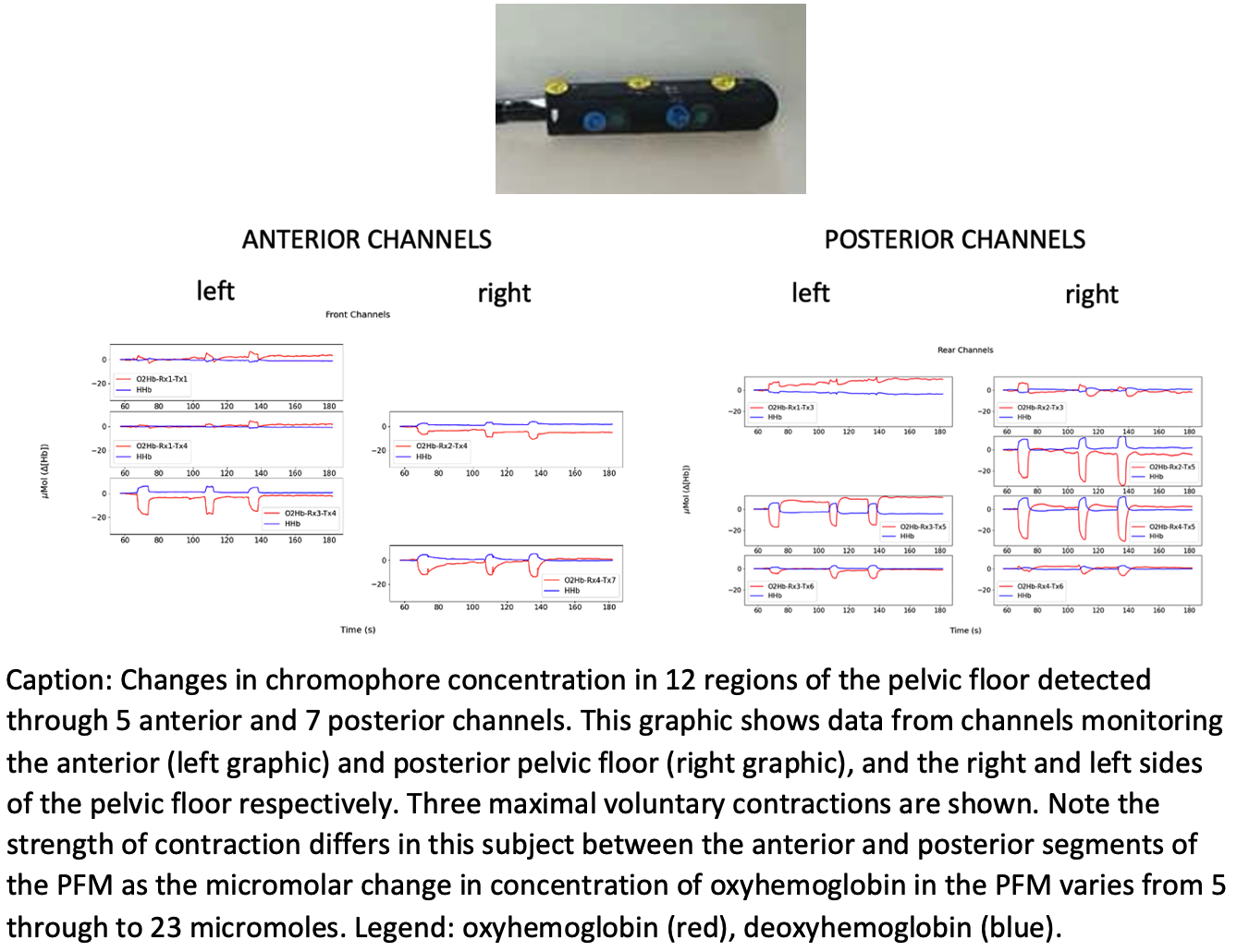Back
Introduction: Women with neurogenic lower urinary tract dysfunction (NLUTD) rely on pelvic floor muscle rehabilitation therapy (PFMT) to aid continence. However, in NLUTD including spinal cord injury (SCI) PFM function is known to be affected regionally/asymmetrically which is not detected through exam or manometry.
Objective: Report clinical translation of a optical PFM system, patient informed design to provide a 3D measures of PFM contractions quantifiable by reoxygenation recovery following sustained maximal voluntary contractions (SMVC) employed in PFMT.
Methods: An optical transvaginal interface was engineered using a circumferential grid of 6 light emitting diodes (LED’s) (wavelengths 750 & 860nm) & 4 photodiode detectors. Engineering design met preferences for size, shape, weight & ergometric features from a prior end user survey (Fig 1) Sampling at 50Hz, changes in oxy and deoxy-hemoglobin concentration (O2Hb/HHb) during PFM contractions monitored in real time, multiple point, from which HbDiff (O2Hb-HHb) is derived. All completed pre/post Qualiveen, were evaluated via NIRS during a standardized sequence of maximum & sustained PFM contractions, engaged in 12 weeks home based PFMT then repeat optical-derived measures of reoxygenation recovery.
Results: N=14 women (5 controls 7 NLUTD) 25 – 82 yrs. Baseline Qualiveen scores range: 0 (controls) - 0.7 (NLUTD). Fig 1: output showing post PFMT composite graphics with NIRS data from channels monitoring the right & left sides of both the anterior & posterior segments of the PFM during 3 SMVC’s. All subjects were monitored successfully pre/post PFMT demonstrating 3D detailed functional ability of small segments of the pelvic floor & documenting effects of training.
Conclusions: Optical detection of a validated quantifiable parameter of muscle reoxygenation in the PFM is feasible using this transvaginal optical interface designed based on women with NLUTD end user feedback. The multipoint design allows small regional variations in PFM functionality to be quantified & improvements from PFMT training effects to be measured in NLUTD/SCI to enhance rehabilitation of women living with NLUTD known to impact negatively on quality of life. SOURCE OF
Funding: Craig H Neilsen Foundation

Moderated Poster Session
Session: MP37: Urodynamics/Lower Urinary Tract Dysfunction/Female Pelvic Medicine: Female Incontinence: Therapy II
MP37-18: A prospective cohort study demonstrating exercise effects from home based pelvic floor muscle training to rehabilitate neurogenic lower urinary tract dysfunction; 3D regional effects
Saturday, April 29, 2023
1:00 PM – 3:00 PM CST
Location: S401A
- LS
Lynn Stothers, MD
University of British Columbia
Poster Presenter(s)
Introduction: Women with neurogenic lower urinary tract dysfunction (NLUTD) rely on pelvic floor muscle rehabilitation therapy (PFMT) to aid continence. However, in NLUTD including spinal cord injury (SCI) PFM function is known to be affected regionally/asymmetrically which is not detected through exam or manometry.
Objective: Report clinical translation of a optical PFM system, patient informed design to provide a 3D measures of PFM contractions quantifiable by reoxygenation recovery following sustained maximal voluntary contractions (SMVC) employed in PFMT.
Methods: An optical transvaginal interface was engineered using a circumferential grid of 6 light emitting diodes (LED’s) (wavelengths 750 & 860nm) & 4 photodiode detectors. Engineering design met preferences for size, shape, weight & ergometric features from a prior end user survey (Fig 1) Sampling at 50Hz, changes in oxy and deoxy-hemoglobin concentration (O2Hb/HHb) during PFM contractions monitored in real time, multiple point, from which HbDiff (O2Hb-HHb) is derived. All completed pre/post Qualiveen, were evaluated via NIRS during a standardized sequence of maximum & sustained PFM contractions, engaged in 12 weeks home based PFMT then repeat optical-derived measures of reoxygenation recovery.
Results: N=14 women (5 controls 7 NLUTD) 25 – 82 yrs. Baseline Qualiveen scores range: 0 (controls) - 0.7 (NLUTD). Fig 1: output showing post PFMT composite graphics with NIRS data from channels monitoring the right & left sides of both the anterior & posterior segments of the PFM during 3 SMVC’s. All subjects were monitored successfully pre/post PFMT demonstrating 3D detailed functional ability of small segments of the pelvic floor & documenting effects of training.
Conclusions: Optical detection of a validated quantifiable parameter of muscle reoxygenation in the PFM is feasible using this transvaginal optical interface designed based on women with NLUTD end user feedback. The multipoint design allows small regional variations in PFM functionality to be quantified & improvements from PFMT training effects to be measured in NLUTD/SCI to enhance rehabilitation of women living with NLUTD known to impact negatively on quality of life. SOURCE OF
Funding: Craig H Neilsen Foundation

